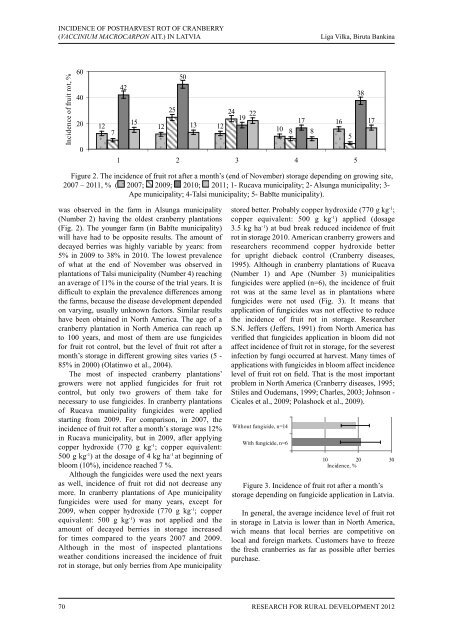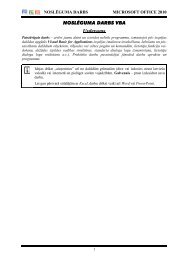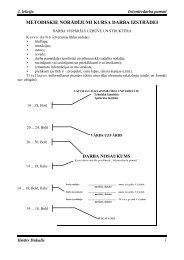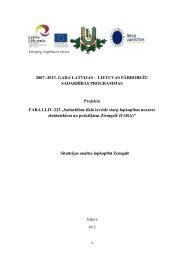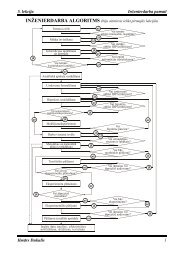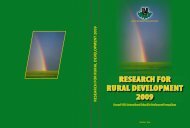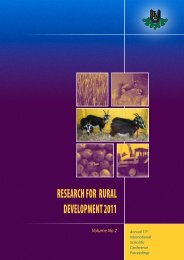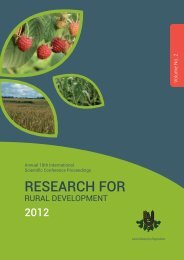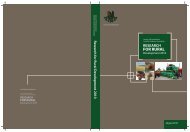LATVIA UNIVERSITY OF AGRICULTURE - Latvijas ...
LATVIA UNIVERSITY OF AGRICULTURE - Latvijas ...
LATVIA UNIVERSITY OF AGRICULTURE - Latvijas ...
- No tags were found...
Create successful ePaper yourself
Turn your PDF publications into a flip-book with our unique Google optimized e-Paper software.
INCIDENCE <strong>OF</strong> POSTHARVEST ROT <strong>OF</strong> CRANBERRY(VACCINIUM MACROCARPON AIT.) IN <strong>LATVIA</strong>Liga Vilka, Biruta BankinaIncidence of fruit rot, %604020050423825 24 221915 17 1612 12 13 12 1078 851 2 3 4 517Figure 2. The incidence of fruit rot after a month’s (end of November) storage depending on growing site,2007 – 2011, % ( 2007; 2009; 2010; 2011; 1- Rucava municipality; 2- Alsunga municipality; 3-Ape municipality; 4-Talsi municipality; 5- Babīte municipality).was observed in the farm in Alsunga municipality(Number 2) having the oldest cranberry plantations(Fig. 2). The younger farm (in Babīte municipality)will have had to be opposite results. The amount ofdecayed berries was highly variable by years: from5% in 2009 to 38% in 2010. The lowest prevalenceof what at the end of November was observed inplantations of Talsi municipality (Number 4) reachingan average of 11% in the course of the trial years. It isdifficult to explain the prevalence differences amongthe farms, because the disease development dependedon varying, usually unknown factors. Similar resultshave been obtained in North America. The age of acranberry plantation in North America can reach upto 100 years, and most of them are use fungicidesfor fruit rot control, but the level of fruit rot after amonth’s storage in different growing sites varies (5 -85% in 2000) (Olatinwo et al., 2004).The most of inspected cranberry plantations’growers were not applied fungicides for fruit rotcontrol, but only two growers of them take fornecessary to use fungicides. In cranberry plantationsof Rucava municipality fungicides were appliedstarting from 2009. For comparison, in 2007, theincidence of fruit rot after a month’s storage was 12%in Rucava municipality, but in 2009, after applyingcopper hydroxide (770 g kg -1 ; copper equivalent:500 g kg -1 ) at the dosage of 4 kg ha -1 at beginning ofbloom (10%), incidence reached 7 %.Although the fungicides were used the next yearsas well, incidence of fruit rot did not decrease anymore. In cranberry plantations of Ape municipalityfungicides were used for many years, except for2009, when copper hydroxide (770 g kg -1 ; copperequivalent: 500 g kg -1 ) was not applied and theamount of decayed berries in storage increasedfor times compared to the years 2007 and 2009.Although in the most of inspected plantationsweather conditions increased the incidence of fruitrot in storage, but only berries from Ape municipalitystored better. Probably copper hydroxide (770 g kg -1 ;copper equivalent: 500 g kg -1 ) applied (dosage3.5 kg ha -1 ) at bud break reduced incidence of fruitrot in storage 2010. American cranberry growers andresearchers recommend copper hydroxide betterfor upright dieback control (Cranberry diseases,1995). Although in cranberry plantations of Rucava(Number 1) and Ape (Number 3) municipalitiesfungicides were applied (n=6), the incidence of fruitrot was at the same level as in plantations wherefungicides were not used (Fig. 3). It means thatapplication of fungicides was not effective to reducethe incidence of fruit rot in storage. ResearcherS.N. Jeffers (Jeffers, 1991) from North America hasverified that fungicides application in bloom did notaffect incidence of fruit rot in storage, for the severestinfection by fungi occurred at harvest. Many times ofapplications with fungicides in bloom affect incidencelevel of fruit rot on field. That is the most importantproblem in North America (Cranberry diseases, 1995;Stiles and Oudemans, 1999; Charles, 2003; Johnson -Cicales et al., 2009; Polashock et al., 2009).Without fungicide, n=14With fungicide, n=610 20 30Incidence, %Figure 3. Incidence of fruit rot after a month’sstorage depending on fungicide application in Latvia.In general, the average incidence level of fruit rotin storage in Latvia is lower than in North America,wich means that local berries are competitive onlocal and foreign markets. Customers have to freezethe fresh cranberries as far as possible after berriespurchase.70 Research for Rural Development 2012


